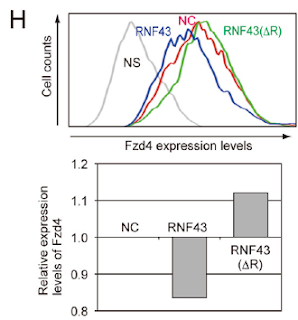Note for: Molecular Role of RNF43 in Canonical and Noncanonical Wnt Signaling
Note for: Molecular Role of RNF43 in Canonical and Noncanonical Wnt Signaling
(doi: 10.1128/MCB.00159-15)
It is a bit hard to follow when reading this paper.
Wnt1 class-- canonical Wnt
go through beta-catenin
Degradation complex includes;
1.adenomatous polyposis coli (APC)
2.axin
3.casein kinase Ialpha (CKIalpha)
4.glycogen synthase kinase 3beta (GSK-3beta)
No Wnt-stimulant --> beta catenin is phosphorylated by degradation cpx leading to degradation by ubiquitin proteasome system by interact through SCFbetaTrCP ubiquitin ligase
Finalized Wnt-catenin activation --> produce c-Myc which maintains undifferentiated state of cells.
Wnt5a class-- non-canonical Wnt
1.not cause accumulation of beta-catenin and no induction of target genes
2.involve in cell polarity and cell migration+antagonizes Wnt/beta-catenin -- play role as tumor suppressor
RNF43 suppresses both canonical and non-canonical but in different manner
--
The research question in this paper is they want to investigate the the functional role of RNF43 toward Wnt signaling, they also elucidate the role of each domain that could contribute to the cancer. There are some experiments that, in my perspective, are a bit hard to convince -- may be it was 3 years ago?
Tool to study Wnt;
Super top flash cell line (STF293) -- it is the cell line that has been genetic engineered to contain the reporter system which illuminate the light once the wnt has been activated (wnt-beta catenin system; ).
Cell line to investigate the basal level of wnt as well as wnt activation;
NIH3T3 (mouse)
MEF (mouse)
ES (mouse)
HEK293 (human)
MCF7 (human - breast cancer)
HepG2 (human - liver cancer)
SW480 (human - colon cancer)
Wnt molecule being used (each wnt molecule initiate different downstream response);
Wnt1
Wnt3a
Wnt8a
Wnt5a
Frizzled receptor being mentioned in this study;
Fzd4
Fzd5
Protein stability (turn-around time of protein);
Using cycloheximide (translational inhibitor -- investigate as time point)
Organelle markers (antibodies);
ER
Rab5 - endosome
Rab7 - late endosome
Rab11 - endosomal trafficking
Each cell has the basal level. However, RNF43 expression is not induced upon Wnt stimulation in every cell type.
First they screen for novel Wnt regulator, they specifically focus on the ubiquitination-dependent regulators of Wnt signaling (not sure how they search and pick since E3 ligase family contain >600).

Show more on the effect of RNF43 toward the phenotype which the Wnt regulates.
Immunoblotting result, RNF43 is tagged by HA, internal control GAPDH
Xenopus development -- using as the tool to investigate the effect from wnt disruption.
Deletion of RING domain --> interrupt the dynamic of Fzd4 receptor on the cell surface.
They delete the PA domains in order to investigate the effect on the wnt (how can they be sure that wnt3a and Fzd4 contributing to these two types of cancers?).//HEK293 has the basal level of Fzd4 and once malfunction version of RNF43 is introduced, Fzd4 accumulates more, NC is empty vector -- Later, they show which part in Fzd where RNF43 interacts --> they used Fzd5 instead of Fzd4, though CRD is conserved?
Linking the patient mutations with the effect on Wnt/beta-catenin; using the top-flash to characterize. There are positive (red) and negative (black) regulators.
They investigated the effect of mutation toward the localization of RNF43 (sample images) -- not only they show the images which sometimes hard to see, but they show the signal intensity from each channel to make sure the overlapping regions are changed.
They examine the role of mutations that contribute to the ubiquitination activity, not so much sure that the smear bands could be firmly used to indicate ubiquitination process, though they compared with and w/o MG132 which is the proteasome inhibitor (RNF43 has the autoubiquitination activity).
Investigate on the RNF43 toward Wnt/non-canonical pw --> activate through Dvl2//observe phenotype on Xenopus developmental stage that represents Wnt/non-canonical and using Wnt5a as the activator.
Series of the C-terminal part of RNF43 mutations toward the effect on Wnt-signaling! (aa318 to 783 -- PDZ-binding motif and histidine rich motif)
Come to the proposed model how RNF43 mutations could contribute to the carcinogenesis.
1. mislocation
2. lost ubiquitination activity
3. equilibrium of RNF43?
PS. Great source for Wnt//click -- they passionate on the wnt-signaling.















Comments
Post a Comment